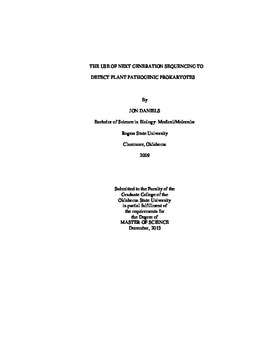| dc.description.abstract | Increasing importation of commodities from countries abroad increases the risk of introduction of exotic plant pathogens. Although individual pathogen assays are available, current screening methods have limited ability to detect multiple plant pathogens concurrently. The advent of next generation sequencing (NGS) technology allows for the creation of a single assay to detect simultaneously, any and all microbes in a sample, including pathogens that have been genetically modified. In this project, bioinformatic pipelines, streamlined PC programs, were developed to generate mock sample databases used to simulate 454 runs, query "electronic probe" (e-probe) design and BLAST searches. Pathogen specific queries, ranging in lengths from 20 nt to 140 nt, were created for detection of the bacterial select agents, Xanthomonas oryzae pv. oryzae and Ralstonia solanacearum race 3 biovar 2, as well as for Candidatus Liberibacter asiaticus and Xylella fastidiosa 9a5c (not select agents). The query sets were used to BLAST mock sample databases with one host, grapevine (Vitis vinifera), for all pathogen sequences at various ratios. All four bacterial pathogens were readily detectable in silico, suggesting that NGS technology has advantages beyond those of existing pathogen detection assays. To test in silico results pathogen specific e-probes, ranging in lengths from 15 nt to 60 nt, were created for detection of Ralstonia solanacearum race 3 biovar 2, and Pseudomonas syringae pv. tomato DC3000. The e-probe sets were used to query NGS sequencing data of diseased hosts, potato inoculated with Rs r3b2, and tomato inoculated with DC3000. Both bacterial pathogens were readily detectable; suggesting NGS data can be used, when combined with e-probes, as a prokaryotic plant pathogen detection assay. This research merges bioinformatics and plant pathology for addressing national security needs of a quick detection tool for any pathogen in a single assay for the agriculture industry. | |
